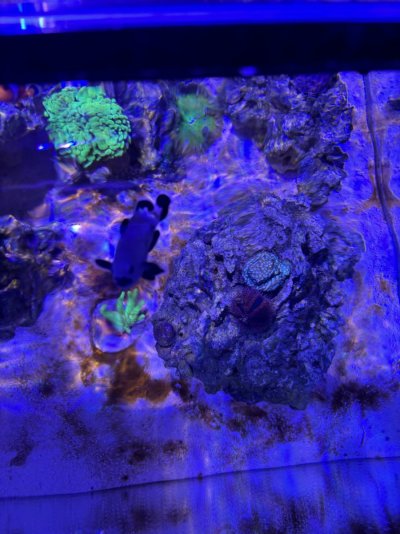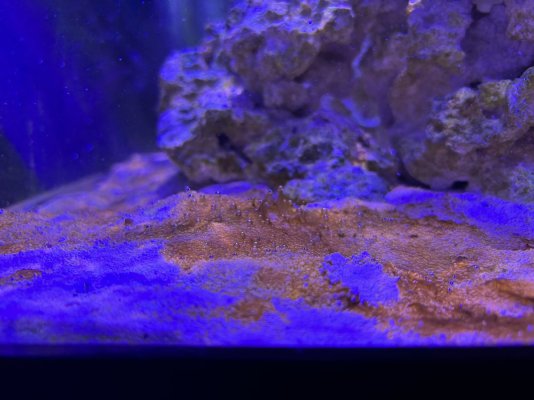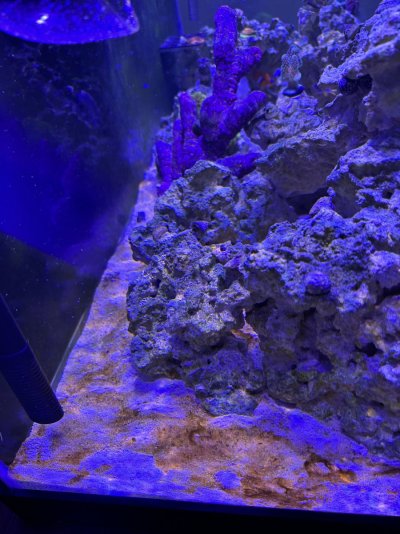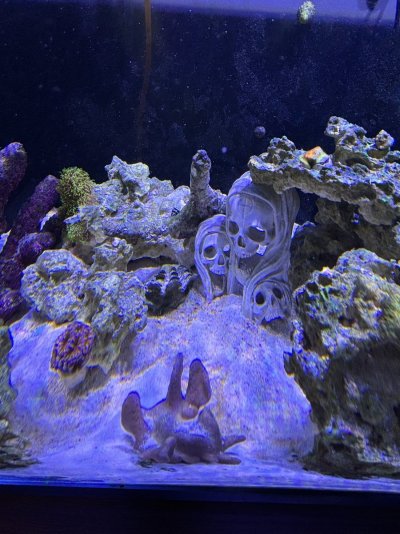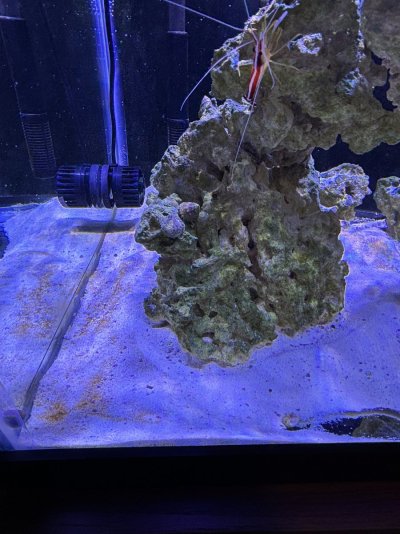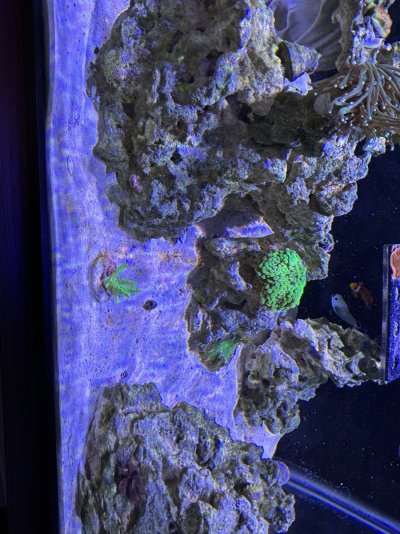Navigation
Install the app
How to install the app on iOS
Follow along with the video below to see how to install our site as a web app on your home screen.
Note: This feature may not be available in some browsers.
More options
You are using an out of date browser. It may not display this or other websites correctly.
You should upgrade or use an alternative browser.
You should upgrade or use an alternative browser.
Help dinos???
- Thread starter briancbuds99
- Start date
- Tagged users None
you are at quite the crossroads
no less than ten million bucks of completely wrecked and lost/taken down reef tanks started exactly where you are, they made choices right after that sealed their tank's fate but it wasn't apparent at the time
so to wind up unlike them, opposite of lost or taken down, you need to do opposite of what the masses recommend and what they did, which is already on file in searchable dinos threads.
you can clearly see that nobody has strong control over dinos when acting through the water, or by chemical changes, or by doing anything at all with nitrate and phosphate. That may be what the masses do/recommend, but it doesn't actually work we can all see the results on file.
go to the nuisance algae forum here, select the first sticky thread up top and see those results.
thats what will happen to your tank if you do anything the masses tell you to do, flip through the results.
the first thing you should do differently in planning, is take no action until someone can link you a thread where for several pages, years worth of work, cure rates are very high vs very low. we shouldn't do anything to your tank until you can see such a control-ability thread.
no less than ten million bucks of completely wrecked and lost/taken down reef tanks started exactly where you are, they made choices right after that sealed their tank's fate but it wasn't apparent at the time
so to wind up unlike them, opposite of lost or taken down, you need to do opposite of what the masses recommend and what they did, which is already on file in searchable dinos threads.
you can clearly see that nobody has strong control over dinos when acting through the water, or by chemical changes, or by doing anything at all with nitrate and phosphate. That may be what the masses do/recommend, but it doesn't actually work we can all see the results on file.
go to the nuisance algae forum here, select the first sticky thread up top and see those results.
thats what will happen to your tank if you do anything the masses tell you to do, flip through the results.
the first thing you should do differently in planning, is take no action until someone can link you a thread where for several pages, years worth of work, cure rates are very high vs very low. we shouldn't do anything to your tank until you can see such a control-ability thread.
Upvote
0
two things you can do as we brainstorm ways to fix your tank vs have done to it what happens in dinos threads (does not get fixed, turns into an alternate invasion for eight months like gha)
1. siphon out all the mats in place before they get larger. make the tank clean by basic easy siphoning, every spot, leave none.
2. how many gallons is your tank, that matters tremendously in planning, and in links easily posted that meet the demands for new ways to battle dinos.
1. siphon out all the mats in place before they get larger. make the tank clean by basic easy siphoning, every spot, leave none.
2. how many gallons is your tank, that matters tremendously in planning, and in links easily posted that meet the demands for new ways to battle dinos.
Upvote
0
Can you post a pic with all white light no blues, just for details it gives
I really want you to see some alternative dinos options before action is taken
before we start testing for things and dosing to them based on someone's advice (I've noticed people's advice in dinos threads seem really confident, but it's hard to find actual work threads with confident control, planning action is wise for sure)
here are some of the top dinos threads underway, let's brainstorm their results before beginning in your tank:
1. largest one I know currently underway:

 www.reef2reef.com
www.reef2reef.com
2. another good one
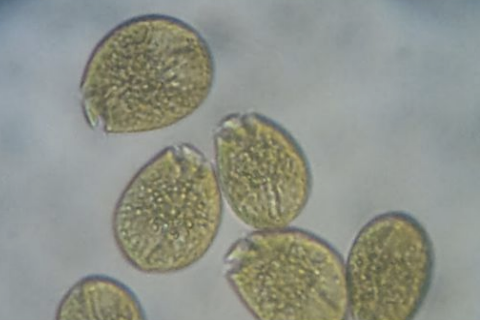
 www.reef2reef.com
www.reef2reef.com
I really want you to see some alternative dinos options before action is taken
before we start testing for things and dosing to them based on someone's advice (I've noticed people's advice in dinos threads seem really confident, but it's hard to find actual work threads with confident control, planning action is wise for sure)
here are some of the top dinos threads underway, let's brainstorm their results before beginning in your tank:
1. largest one I know currently underway:

Dinoflagellates – Are You Tired Of Battling Altogether?
I don't know what percentage of folks had luck battling dinos with any of the methods in the old Dino thread but it's obviously a very low percentage, so I'd like refresh folks on the natural alternatives and lay out three areas of info: some of the factors that contribute to a dino outbreak...
 www.reef2reef.com
www.reef2reef.com
2. another good one
A Dinoflagellate Treatment Guide
As the title suggests, this is intended as a short guide on what to do when you suspect dinoflagellates are trying to overtake your system. It is an attempt to boil down the protocols discussed across 11,000 posts in this "Are you Tired" thread...
 www.reef2reef.com
www.reef2reef.com
Upvote
0
*perhaps your tank won't require big surgery. that's the details we can see in clearer white pics for planning
allowing the mass to remain cannot help any approach, so a quick 100% siphon out removal of them to leave none for the follow up pic is prudent, while we prepare and try to find posted patterns that might actually work.
you can see in link #1, 700 pages of work, the most exhaustive dinos thread read in the world: there's a 5% cure rate potential if they get really bad. you aren't at that stage yet, I think you're sampling options early on which gives us planning time.
you can see in that thread, identification of your species of dinos doesn't help/matter much. It's not like ostreopsis have a high cure rate, or prorocentrum/they're all the same pretty much to the fixers: nobody is curing dinos in pattern in that thread. they're just trying various things to see what sticks; nothing is worked out yet.
what else we can see bigtime as a prep warning from link #1: do not turn your system into an algae farm along the way, that also does not look good. we want to do opposite of any steps that took someone's tank from a dinos tank to a GHA tank, I have that plan in mind.
the species of your invasion doesn't seem to matter much, so, don't go spend money on microscope pics as you can see they all did there.
allowing the mass to remain cannot help any approach, so a quick 100% siphon out removal of them to leave none for the follow up pic is prudent, while we prepare and try to find posted patterns that might actually work.
you can see in link #1, 700 pages of work, the most exhaustive dinos thread read in the world: there's a 5% cure rate potential if they get really bad. you aren't at that stage yet, I think you're sampling options early on which gives us planning time.
you can see in that thread, identification of your species of dinos doesn't help/matter much. It's not like ostreopsis have a high cure rate, or prorocentrum/they're all the same pretty much to the fixers: nobody is curing dinos in pattern in that thread. they're just trying various things to see what sticks; nothing is worked out yet.
what else we can see bigtime as a prep warning from link #1: do not turn your system into an algae farm along the way, that also does not look good. we want to do opposite of any steps that took someone's tank from a dinos tank to a GHA tank, I have that plan in mind.
the species of your invasion doesn't seem to matter much, so, don't go spend money on microscope pics as you can see they all did there.
Upvote
0
I asked about your gallonage for this reason:
nobody in that example thread #1 handles dinos based on gallonage of the tank, they handle them based on species ID. all tank sizes get the same treatment is how they work tanks
smaller tanks are easier to handle physically vs large tanks, large tanks have to be handled and guided chemically moreso since water changes and direct access to all substrate is space-prohibitive in a large system.
60 gallons is mid size, that gives us some physical control options that thread above doesn't care to factor.
physical actions like removing dinos did not cause the gha challenges above in thread example #1, adding fertilizers did, so we should wait a while before ever dosing those. a last-ditch option in fact
in your tank, the top growing layers need removed via simple siphon off the sand. for ones stuck on rocks, lift the rock out of the tank and rinse them off externally with saltwater then set back the cleaned rocks, on cleaned sand. that buys us research time without your tank getting worse as we factor options.
physicality first, not chemistry
physicality vs chemistry and vs species ID< that's the key to getting results and not turning your tank into a GHA farm.
60 gallons isn't impossible to remove the sandbed and try fixing the tank as a barebottom setup, for example. if you have a very mean strain, not based on species ID but based on growback rates, then some of those stepped-up moves will be called for.
*your system does not look bad even in the opening shots. this early simple guiding, total topical removal, is worth the effort and should be done immediately. this is the expected hand guiding for all dry rock cycles, a few mos old is not very aged in terms of dry rock cycles and if this is the first hand guiding needed, that's a pretty good balance in place.
the next step you do is lower your lighting % and lower and whites you have running to zero or just above it, physically changing the light intensity which is currently adapted to growing an invasion is the next step. it doesn't even matter if this is invasive cyano and not dinos, species ID doesn't factor, that lighting trick is the same step regardless. its part of the changes you make before your tank becomes really bad, like in the thread example.
nobody in that example thread #1 handles dinos based on gallonage of the tank, they handle them based on species ID. all tank sizes get the same treatment is how they work tanks
smaller tanks are easier to handle physically vs large tanks, large tanks have to be handled and guided chemically moreso since water changes and direct access to all substrate is space-prohibitive in a large system.
60 gallons is mid size, that gives us some physical control options that thread above doesn't care to factor.
physical actions like removing dinos did not cause the gha challenges above in thread example #1, adding fertilizers did, so we should wait a while before ever dosing those. a last-ditch option in fact
in your tank, the top growing layers need removed via simple siphon off the sand. for ones stuck on rocks, lift the rock out of the tank and rinse them off externally with saltwater then set back the cleaned rocks, on cleaned sand. that buys us research time without your tank getting worse as we factor options.
physicality first, not chemistry
physicality vs chemistry and vs species ID< that's the key to getting results and not turning your tank into a GHA farm.
60 gallons isn't impossible to remove the sandbed and try fixing the tank as a barebottom setup, for example. if you have a very mean strain, not based on species ID but based on growback rates, then some of those stepped-up moves will be called for.
*your system does not look bad even in the opening shots. this early simple guiding, total topical removal, is worth the effort and should be done immediately. this is the expected hand guiding for all dry rock cycles, a few mos old is not very aged in terms of dry rock cycles and if this is the first hand guiding needed, that's a pretty good balance in place.
the next step you do is lower your lighting % and lower and whites you have running to zero or just above it, physically changing the light intensity which is currently adapted to growing an invasion is the next step. it doesn't even matter if this is invasive cyano and not dinos, species ID doesn't factor, that lighting trick is the same step regardless. its part of the changes you make before your tank becomes really bad, like in the thread example.
Last edited:
Upvote
0
Umm...before you do anything...take a sample of the brown stuff and look at it under a microscope and take some photos under high magnification to post on the forum. First identify what it is before you start any tinkering or treatments. It's looking like either diatoms or dino, both can be treated successfully...and each type have different, simple and cost effective treatment options.
Upvote
0
Thank you yea i just cleaned it all off the surface im doing another 15G water change hopefully this doesn’t throw anything off imI asked about your gallonage for this reason:
nobody in that example thread #1 handles dinos based on gallonage of the tank, they handle them based on species ID. all tank sizes get the same treatment is how they work tanks
smaller tanks are easier to handle physically vs large tanks, large tanks have to be handled and guided chemically moreso since water changes and direct access to all substrate is space-prohibitive in a large system.
60 gallons is mid size, that gives us some physical control options that thread above doesn't care to factor.
physical actions like removing dinos did not cause the gha challenges above in thread example #1, adding fertilizers did, so we should wait a while before ever dosing those. a last-ditch option in fact
in your tank, the top growing layers need removed via simple siphon off the sand. for ones stuck on rocks, lift the rock out of the tank and rinse them off externally with saltwater then set back the cleaned rocks, on cleaned sand. that buys us research time without your tank getting worse as we factor options.
physicality first, not chemistry
physicality vs chemistry and vs species ID< that's the key to getting results and not turning your tank into a GHA farm.
60 gallons isn't impossible to remove the sandbed and try fixing the tank as a barebottom setup, for example. if you have a very mean strain, not based on species ID but based on growback rates, then some of those stepped-up moves will be called for.
*your system does not look bad even in the opening shots. this early simple guiding, total topical removal, is worth the effort and should be done immediately. this is the expected hand guiding for all dry rock cycles, a few mos old is not very aged in terms of dry rock cycles and if this is the first hand guiding needed, that's a pretty good balance in place.
the next step you do is lower your lighting % and lower and whites you have running to zero or just above it, physically changing the light intensity which is currently adapted to growing an invasion is the next step. it doesn't even matter if this is invasive cyano and not dinos, species ID doesn't factor, that lighting trick is the same step regardless. its part of the changes you make before your tank becomes really bad, like in the thread example.
Also adding a power head lower on the sand cuss of my rock scape i have allot of dead spots i turned down the lights .. last time my emerald crab ate off it the rocks but i had to get rid of him cuss he started eating corals he was huge .. il do more research last resort il bring the lights down completely and move the corals to another tank i have a small QT il try to get rid of this with out chemicals
Upvote
0
Dont know if this matters i found a dead fish in my filtration he was badly decomposed im a trucker so if my wife doesn’t notice a fish is missing it wont be found till i get back from
The road
The road
Upvote
0
agreed that will factor.
don't move corals out yet, given the details. only do what's advised / in progress, the full cleanup and reducing the lights some degree, don't cut them/those corals still need some light but not as much. focus on cleaning out the tank, any dead zones etc and we watch the growback from the clean condition. no big changes are done in this first go
don't move corals out yet, given the details. only do what's advised / in progress, the full cleanup and reducing the lights some degree, don't cut them/those corals still need some light but not as much. focus on cleaning out the tank, any dead zones etc and we watch the growback from the clean condition. no big changes are done in this first go
Upvote
0
You posted stable parameters, but I don’t see any read on nutrient levels being maintained?Dont know if this matters i found a dead fish in my filtration he was badly decomposed im a trucker so if my wife doesn’t notice a fish is missing it wont be found till i get back from
The road
Too low or zero nutrient levels favour pest algae and bacteria. It starved everything including the development of those critters which keep our rocks clean and sand white.
Too high not great either.
What have these been running at in your system?
Upvote
0
i dose all for reef and stability after every 10+ gallon water change i haven’t messed with my filtration since i started the tank i do run a UV sterilizer and i have a protein skimmer iv never tested my nutrition levels il do that next … i do want to say i use distilled water instead of rodi
Upvote
0
Its coming back ima go in again and just run the gravel vac and get rid of that surfaceok it's the next day
is your tank cleaned up/did you have the pics requested in white light
Attachments
Upvote
0
Similar threads
- Replies
- 11
- Views
- 248
- Replies
- 2
- Views
- 289
TOP 10 Trending Threads
- Replies
- 52
- Views
- 629
-
- Poll
- Replies
- 23
- Views
- 297
- Replies
- 27
- Views
- 437
-
- Poll
- Replies
- 32
- Views
- 466
- Replies
- 54
- Views
- 1,143
- Replies
- 64
- Views
- 569
- Question
- Replies
- 65
- Views
- 701
- Replies
- 36
- Views
- 427
- Replies
- 31
- Views
- 448
New Posts
-
How to size heater for 100 gallon tank
- Latest: All-in Salt Tank


